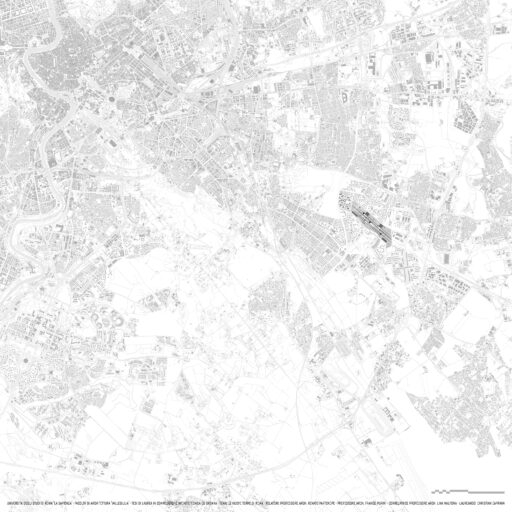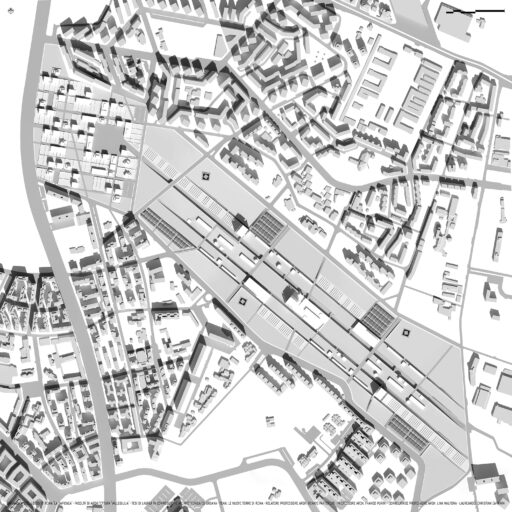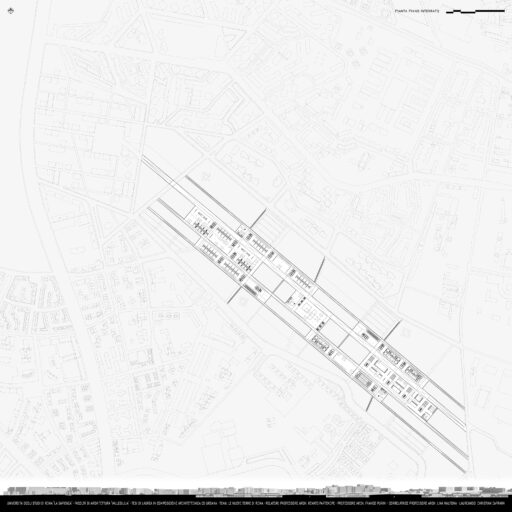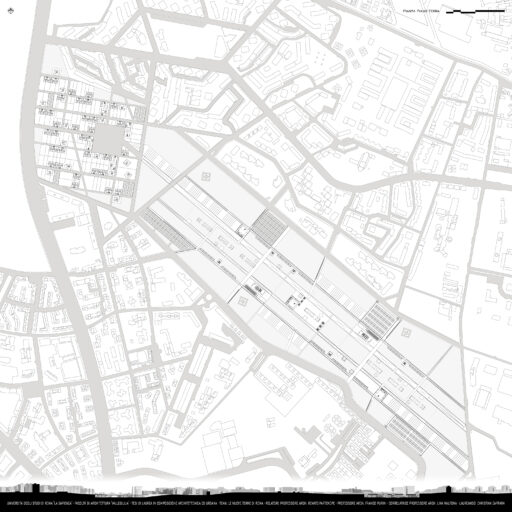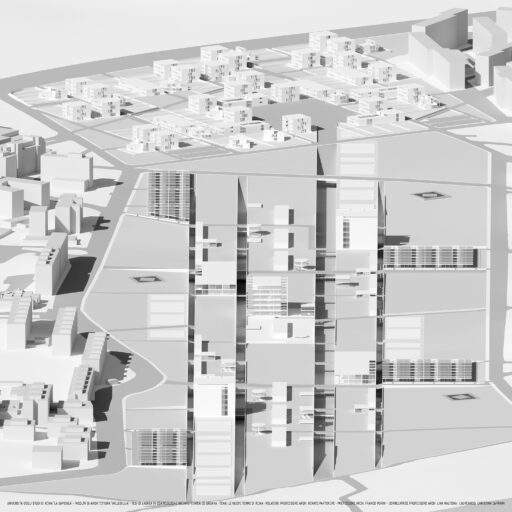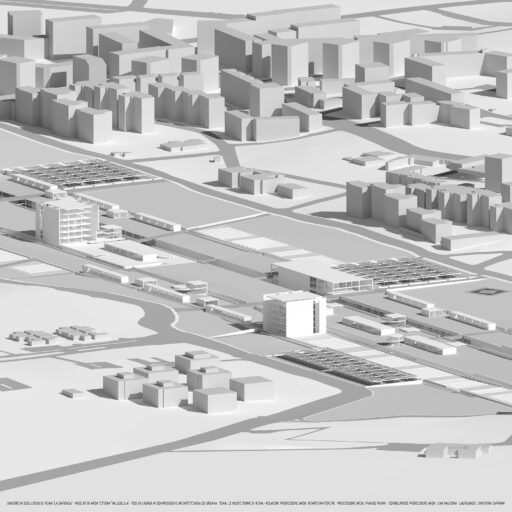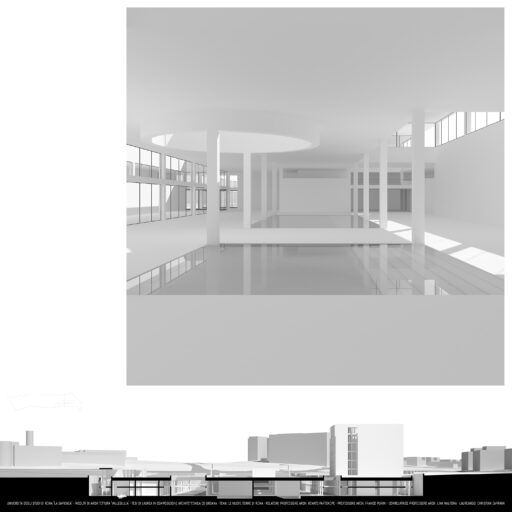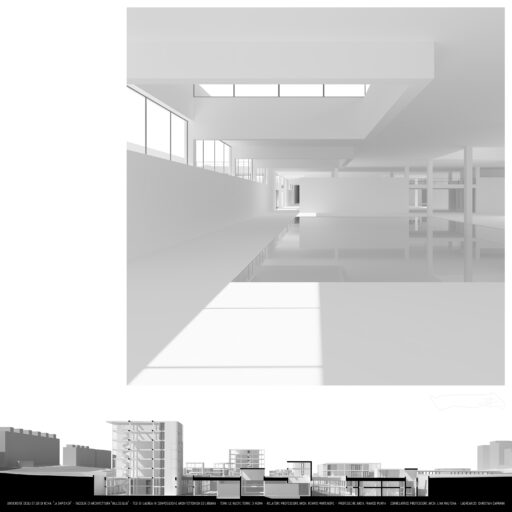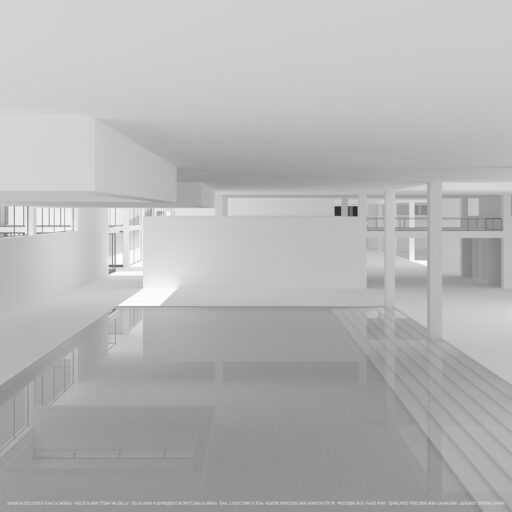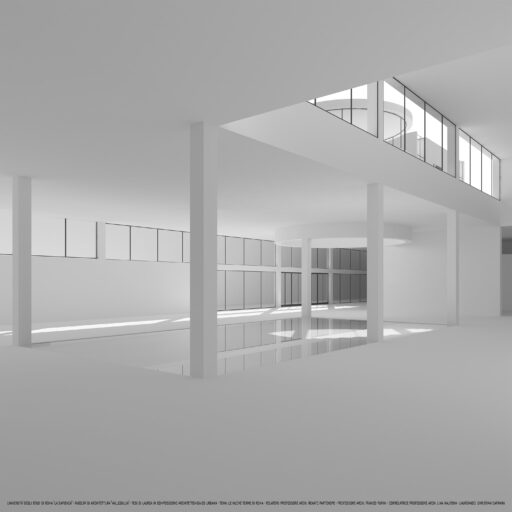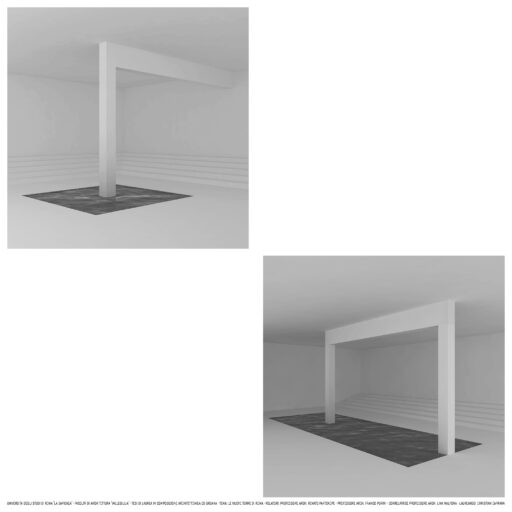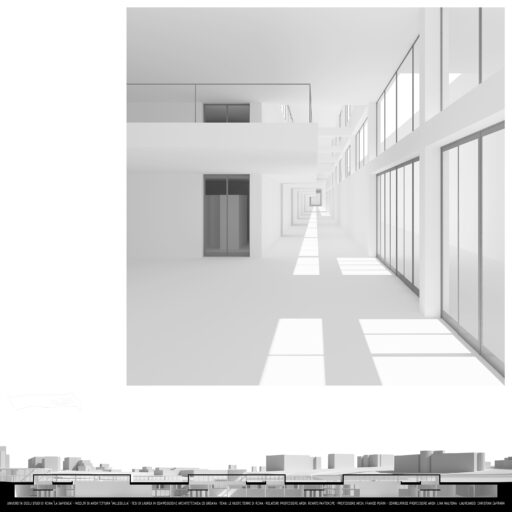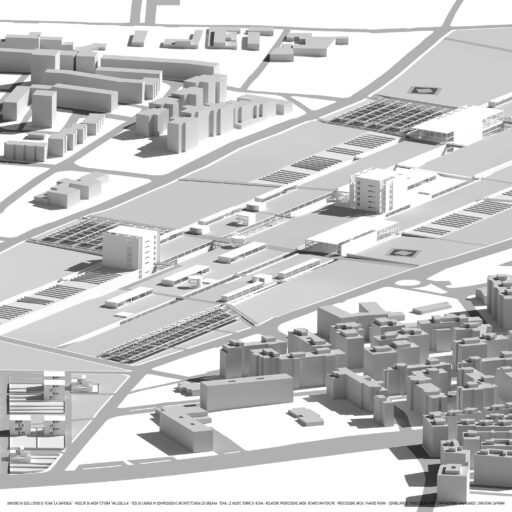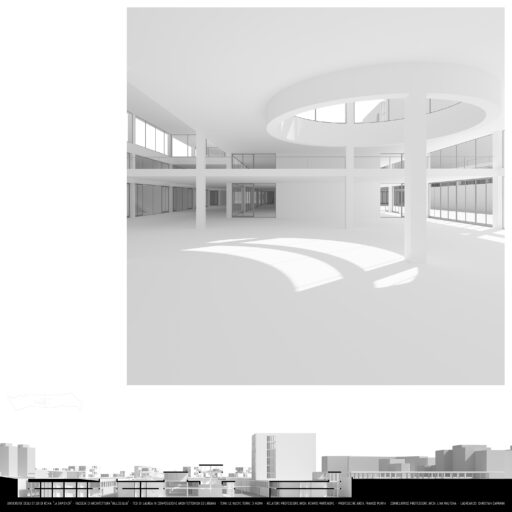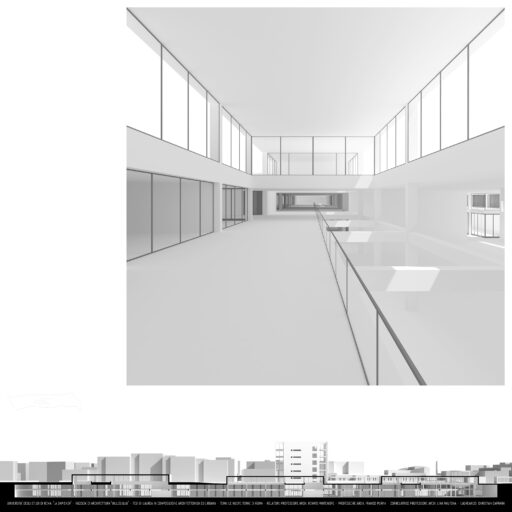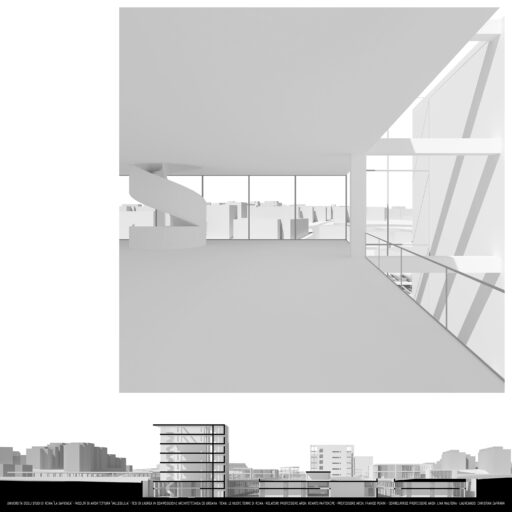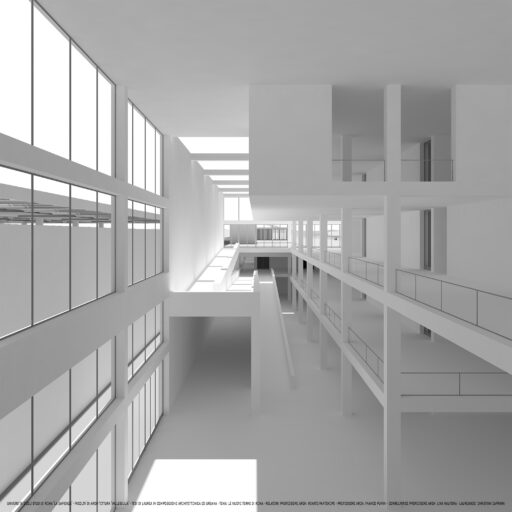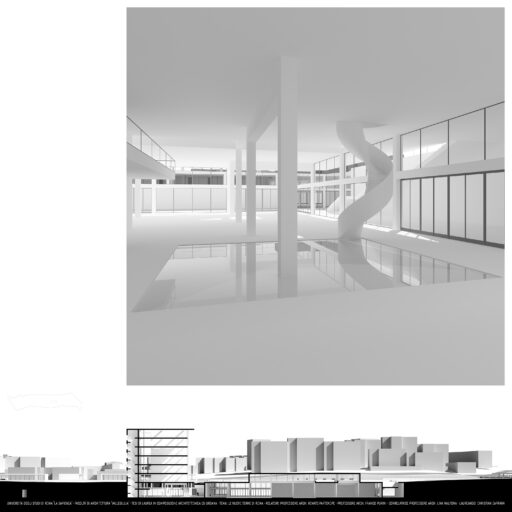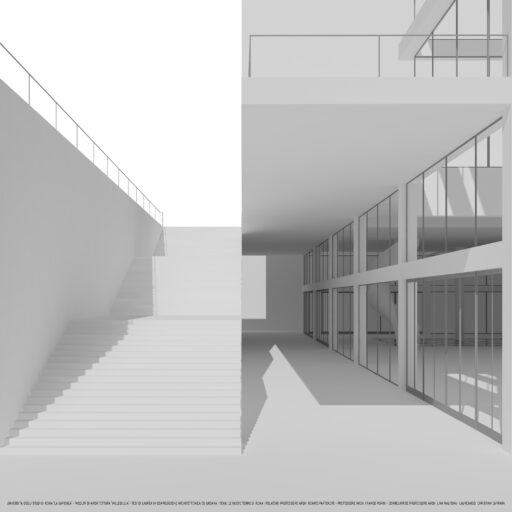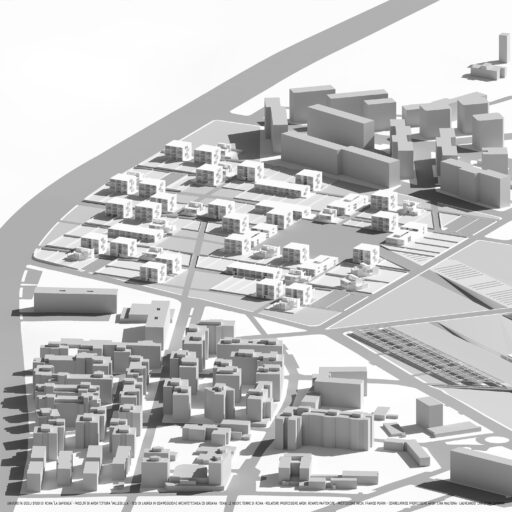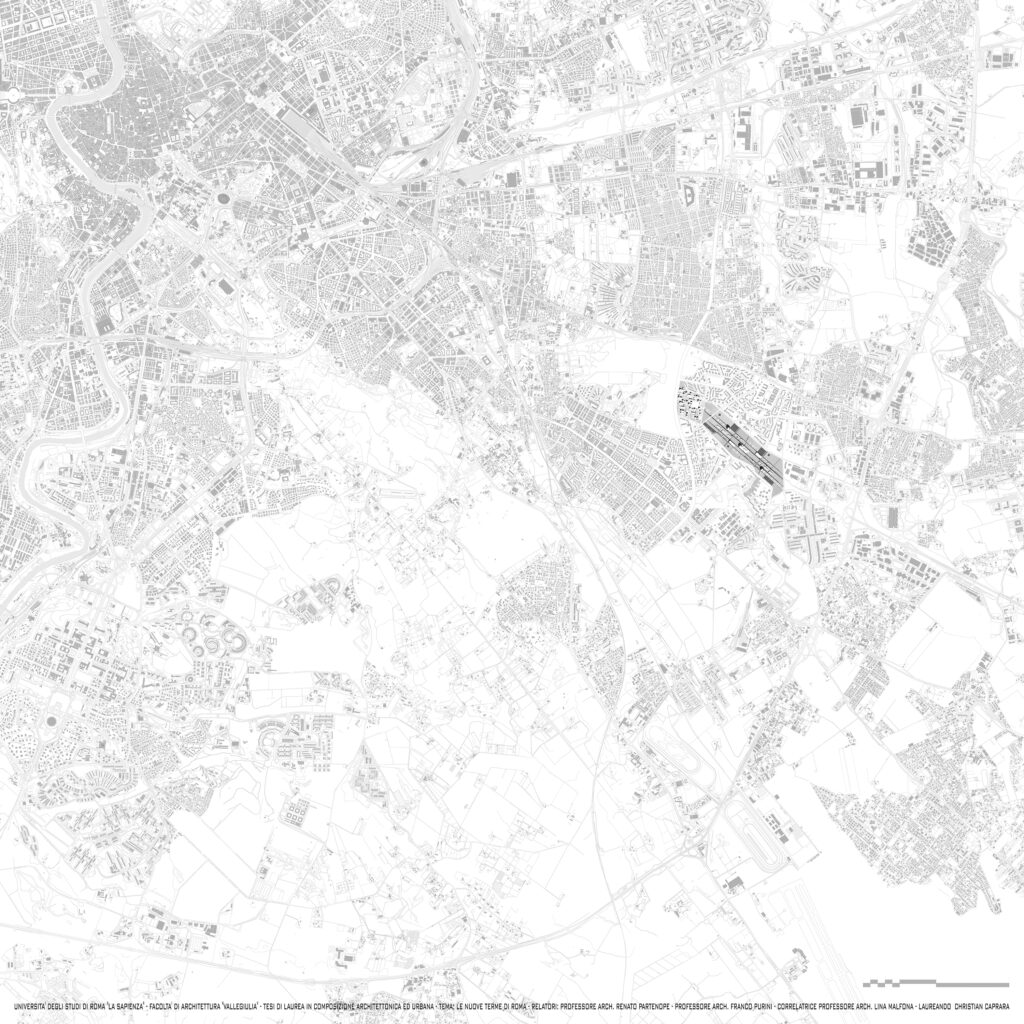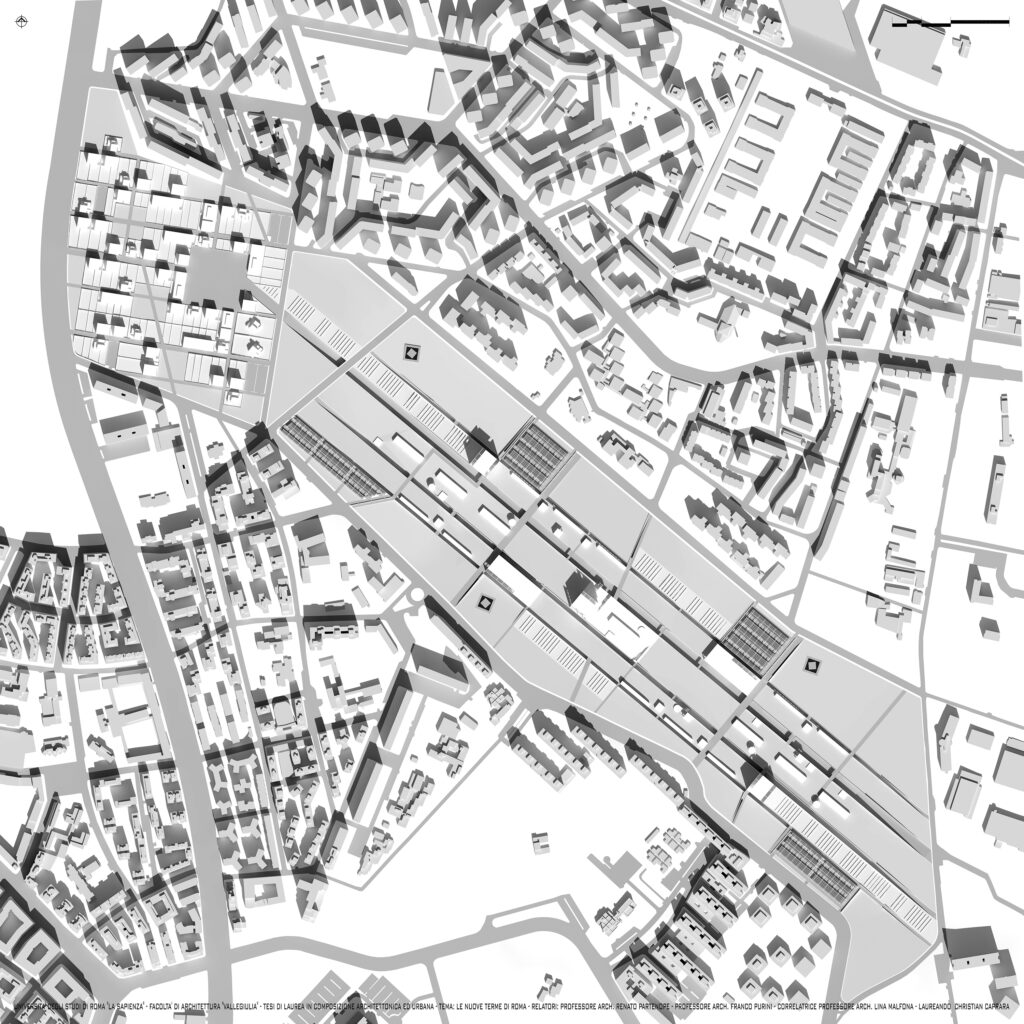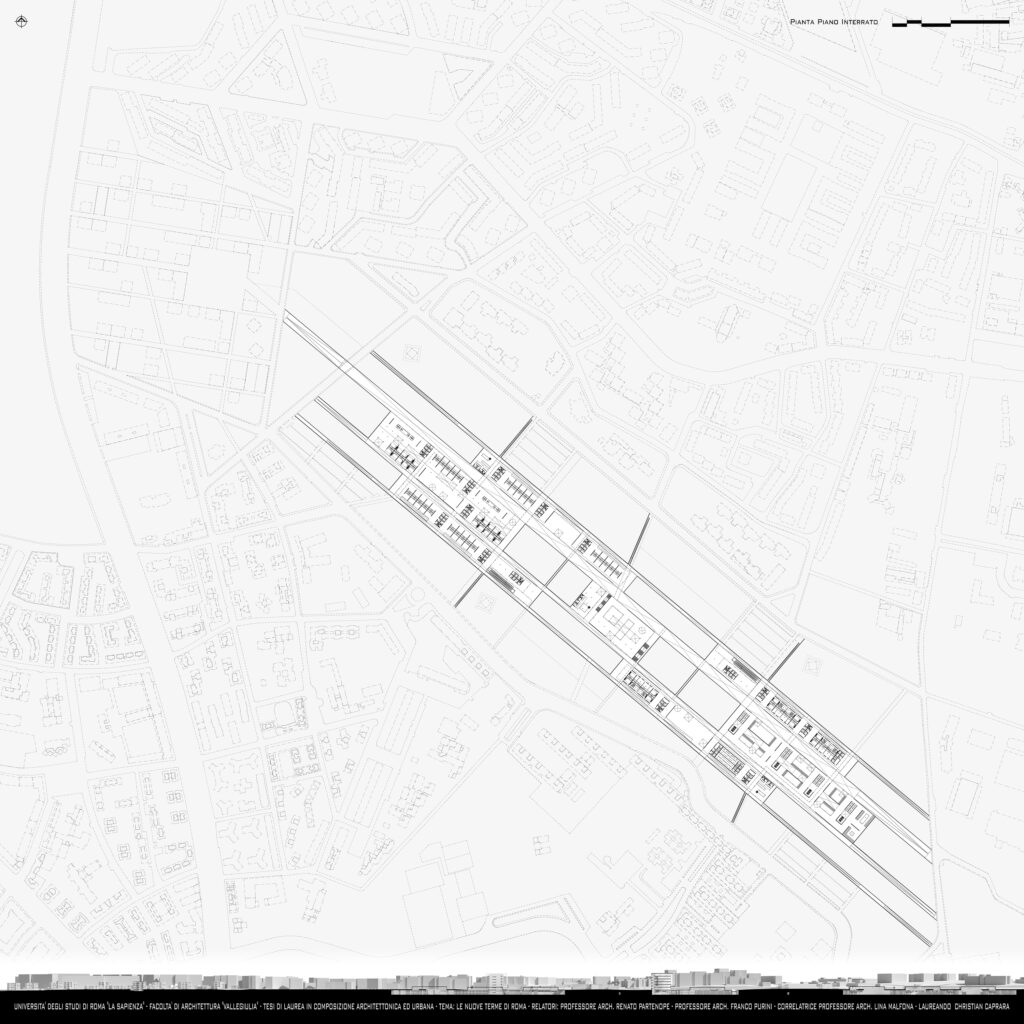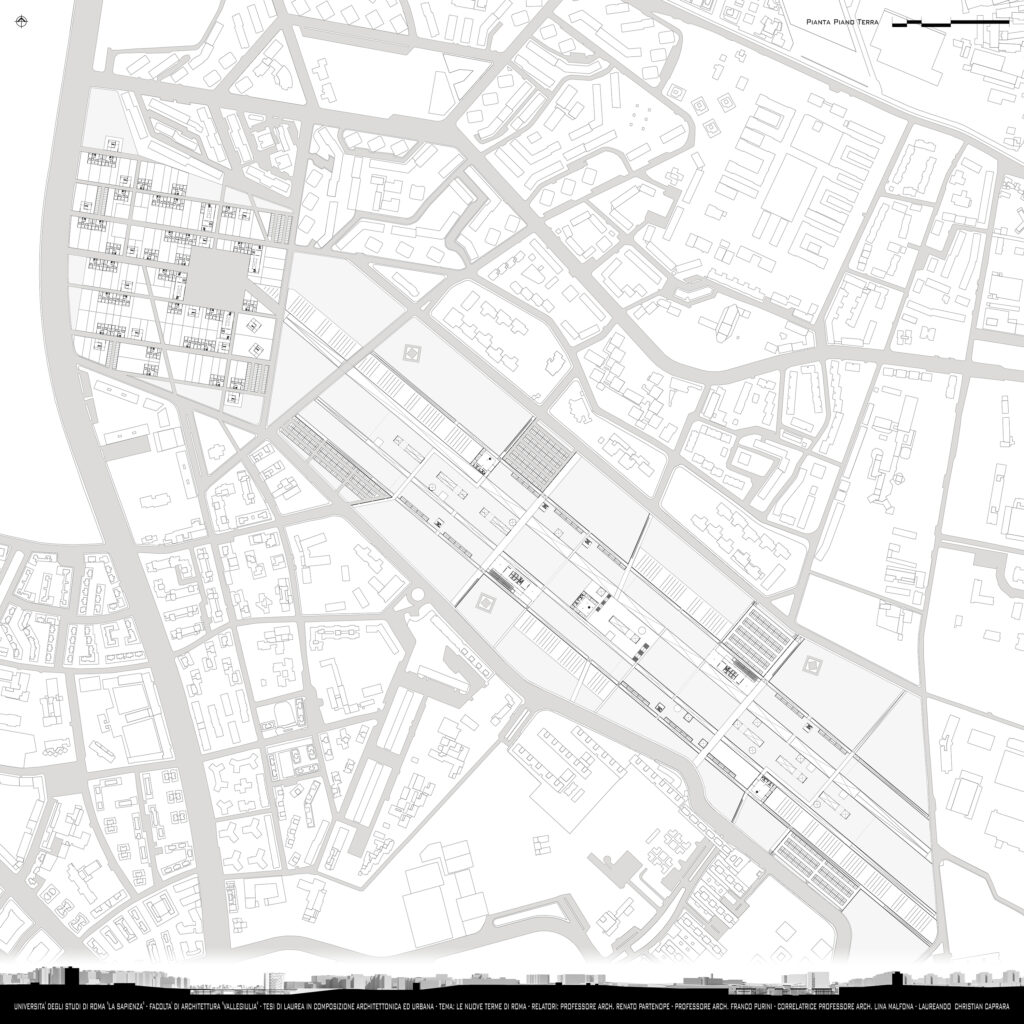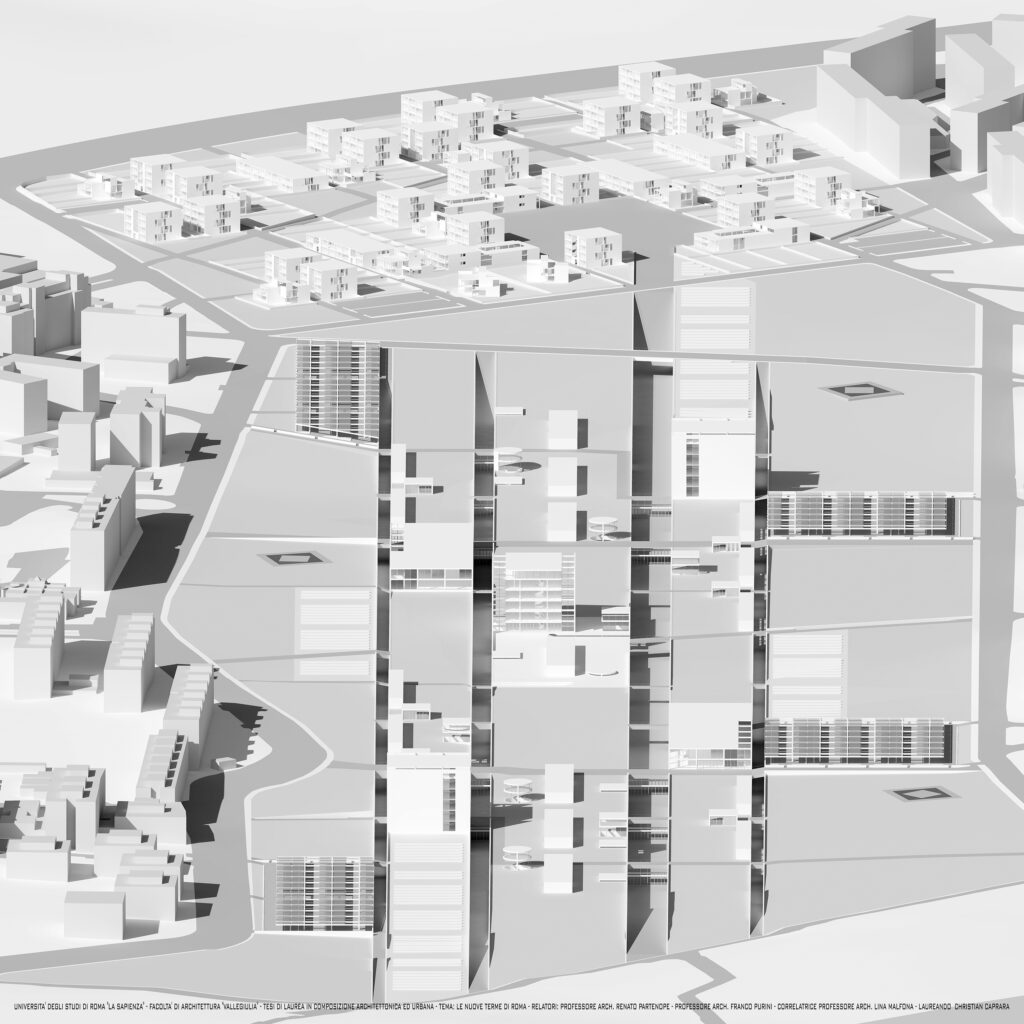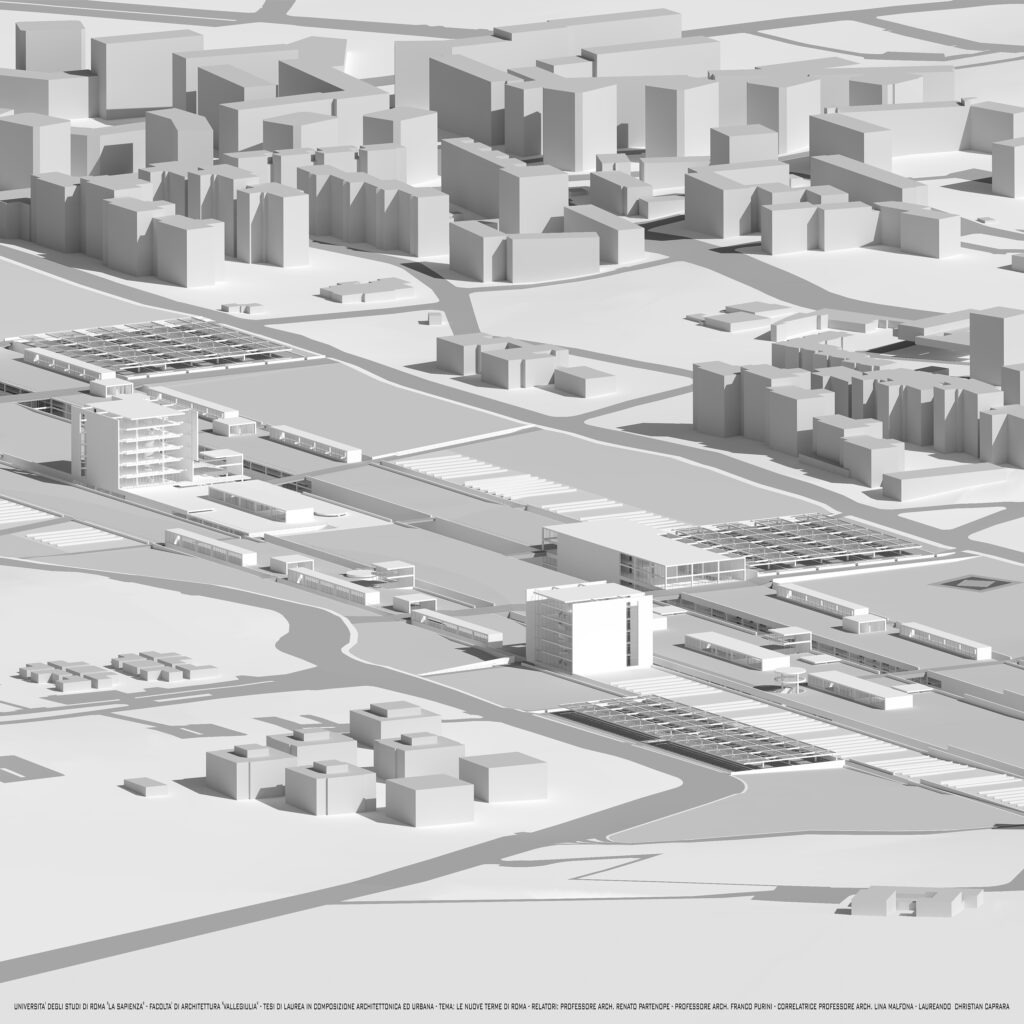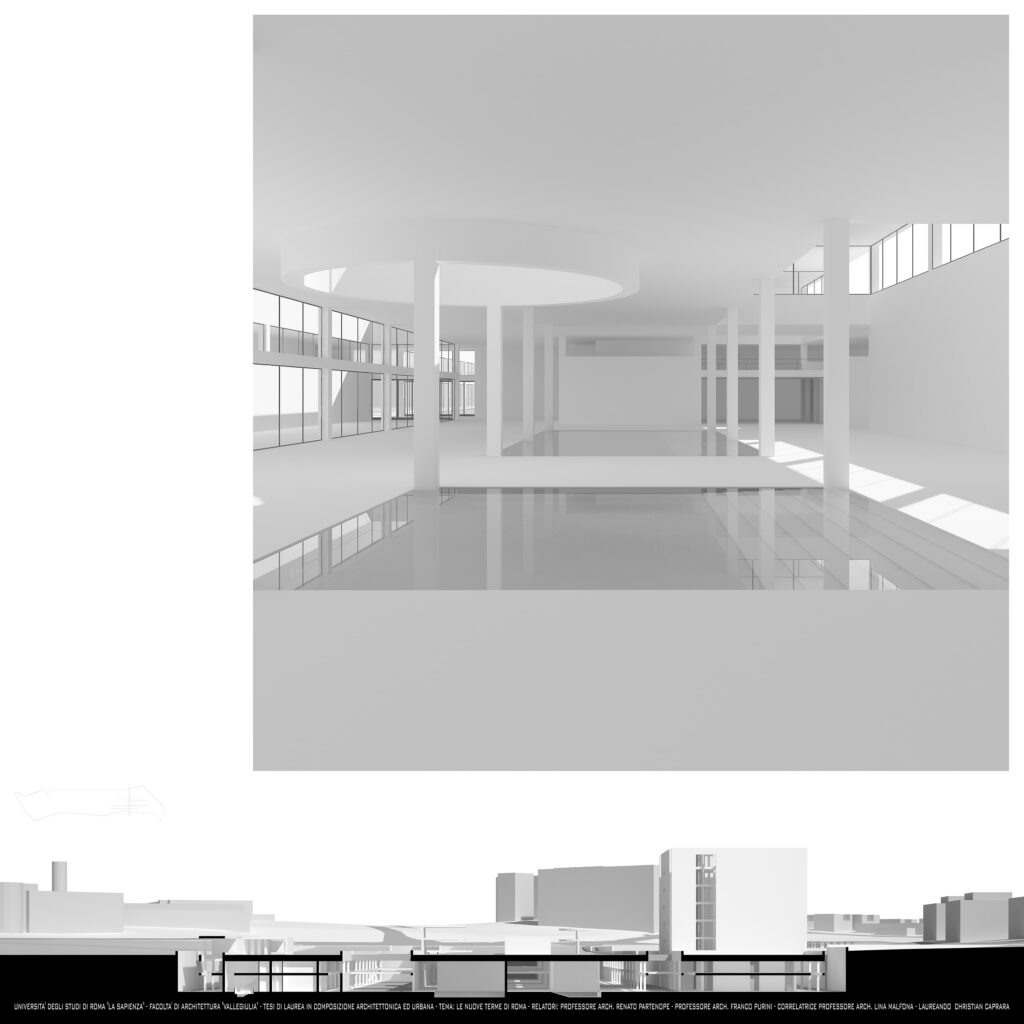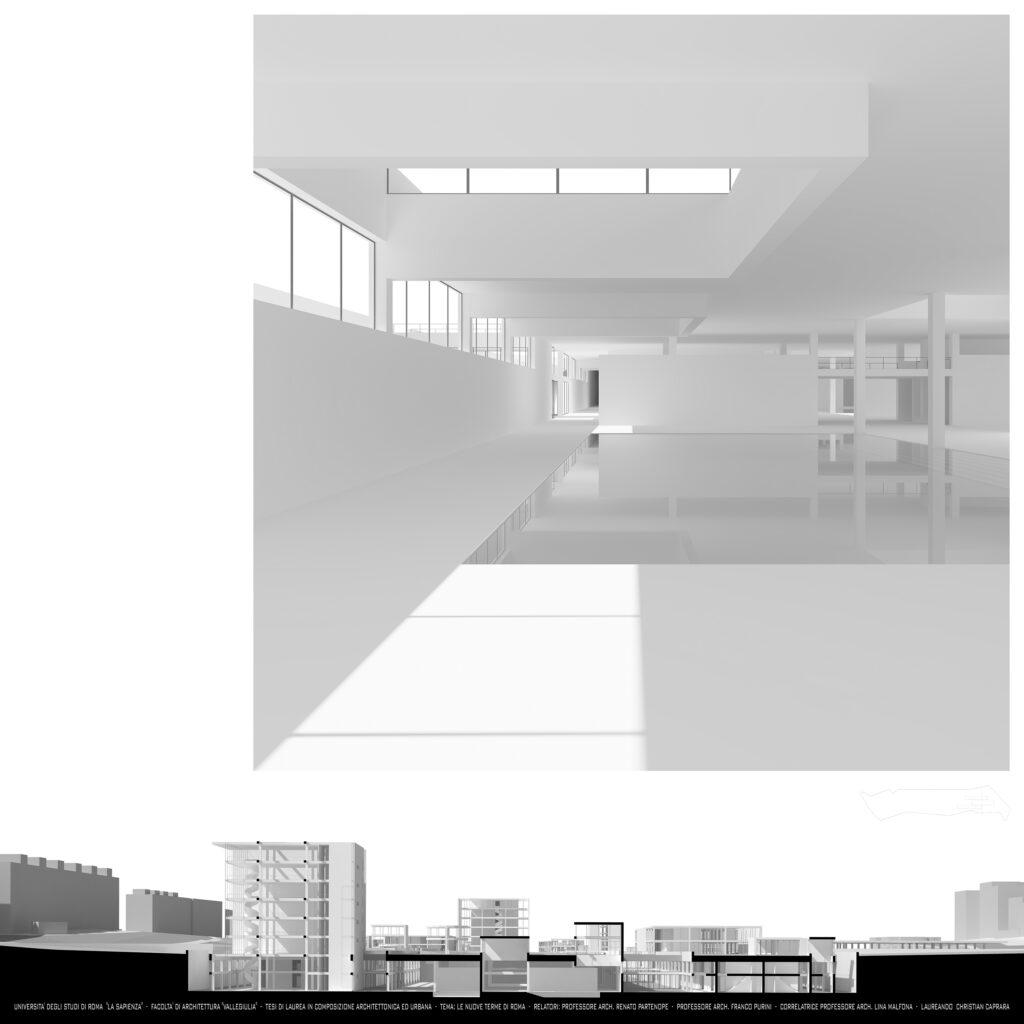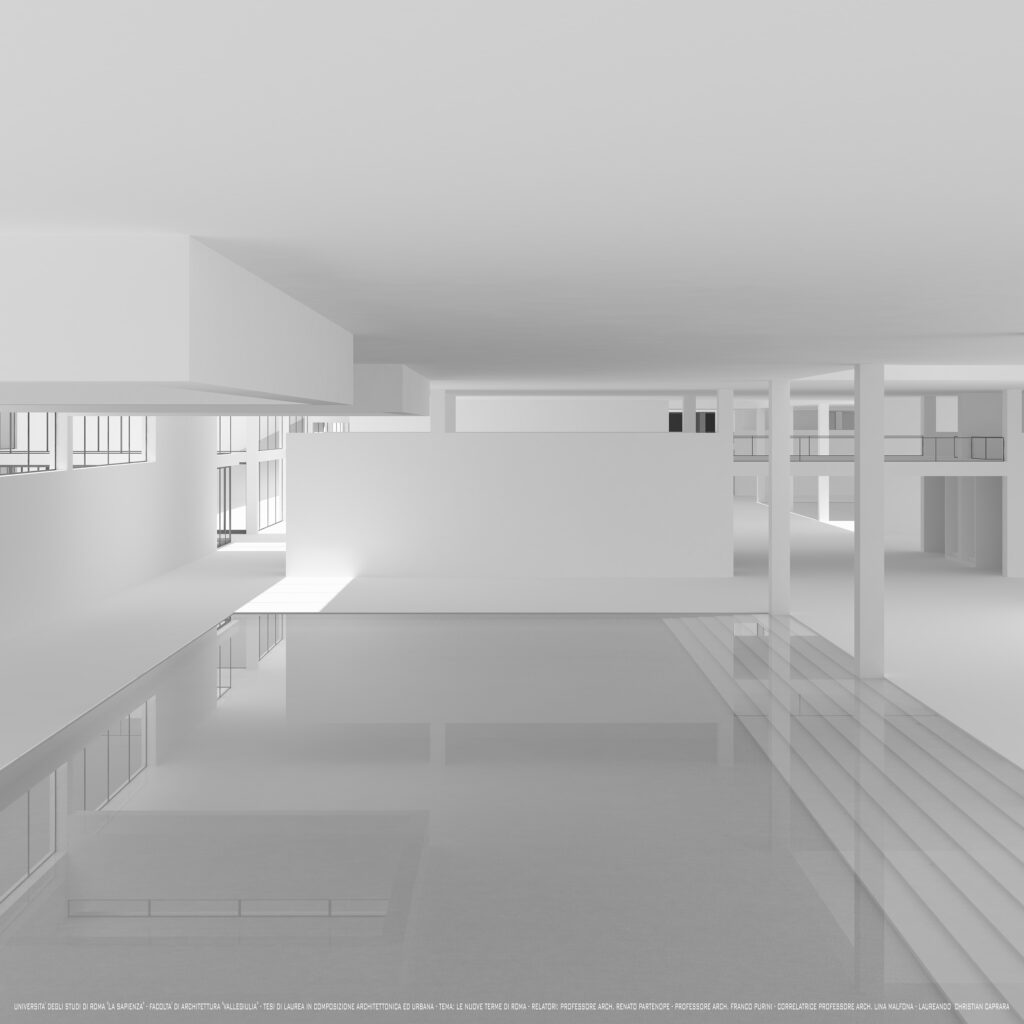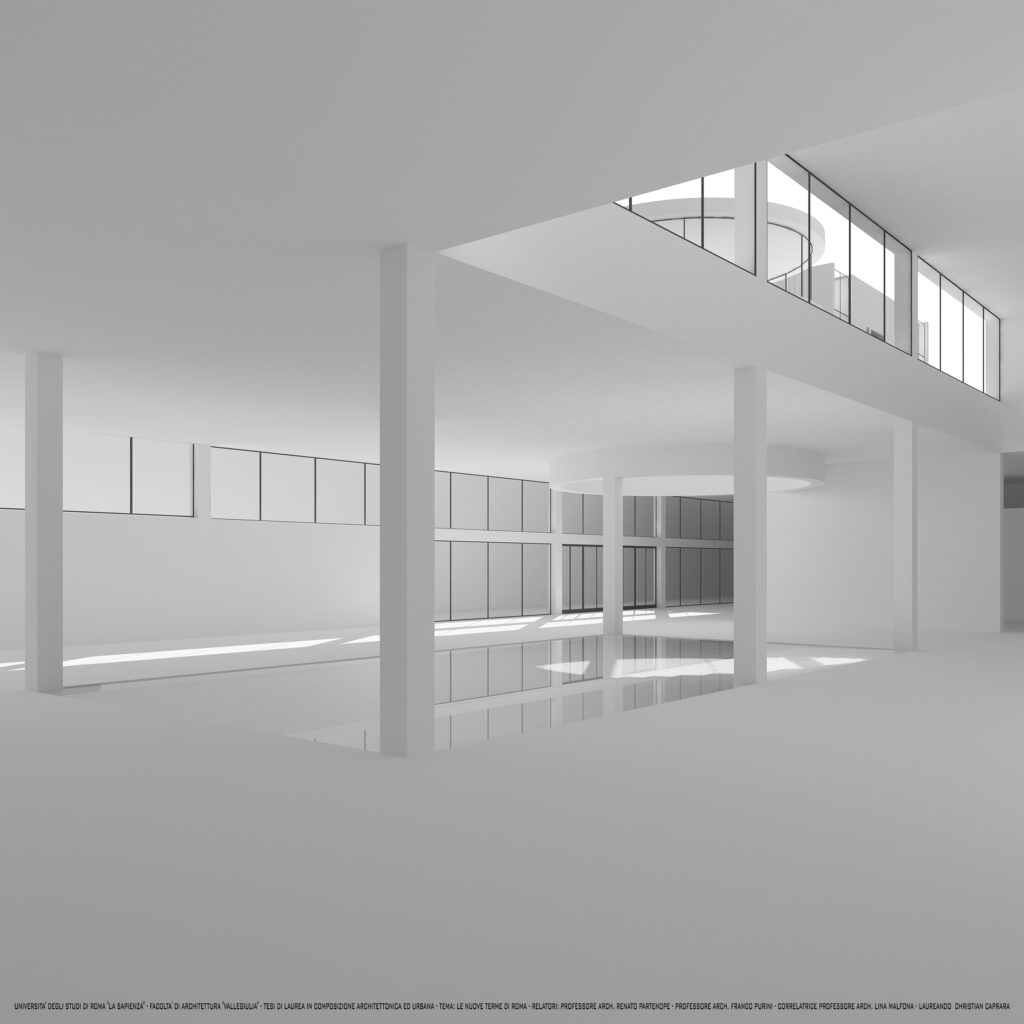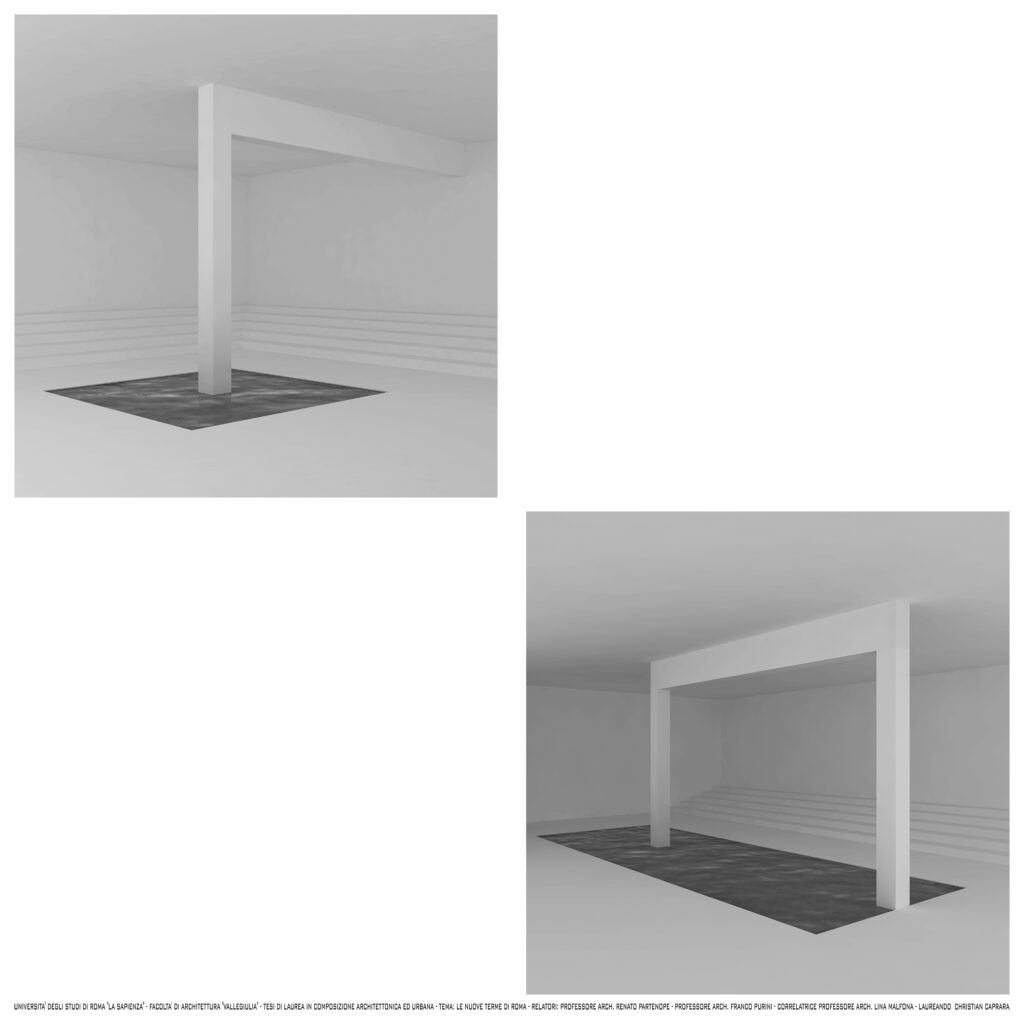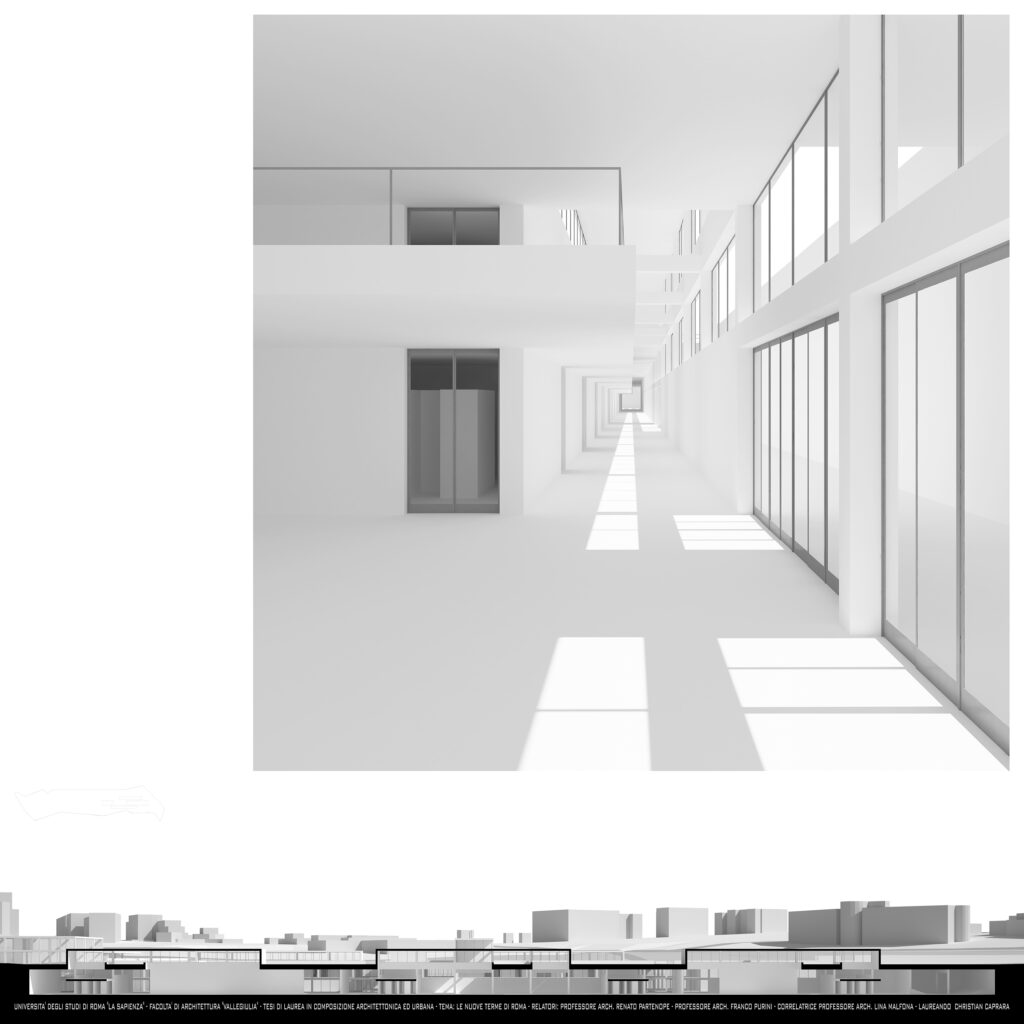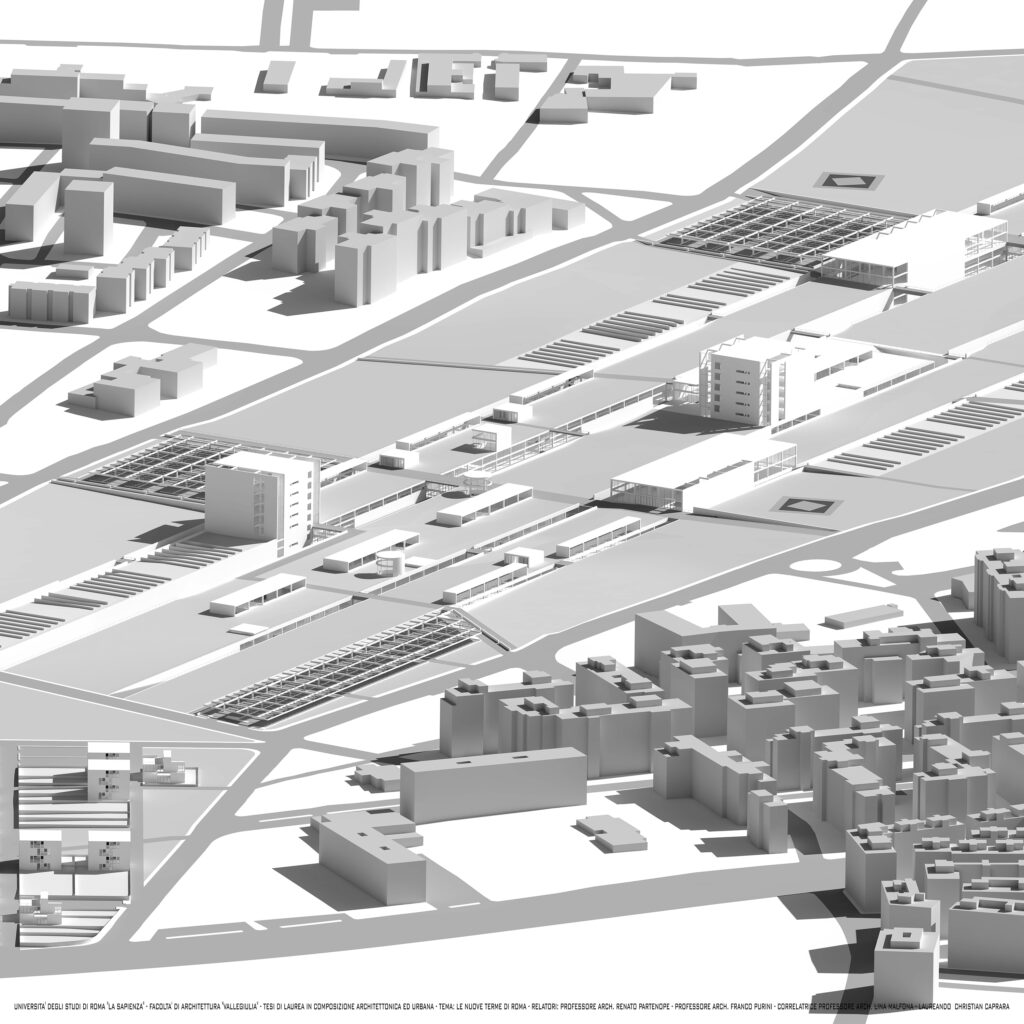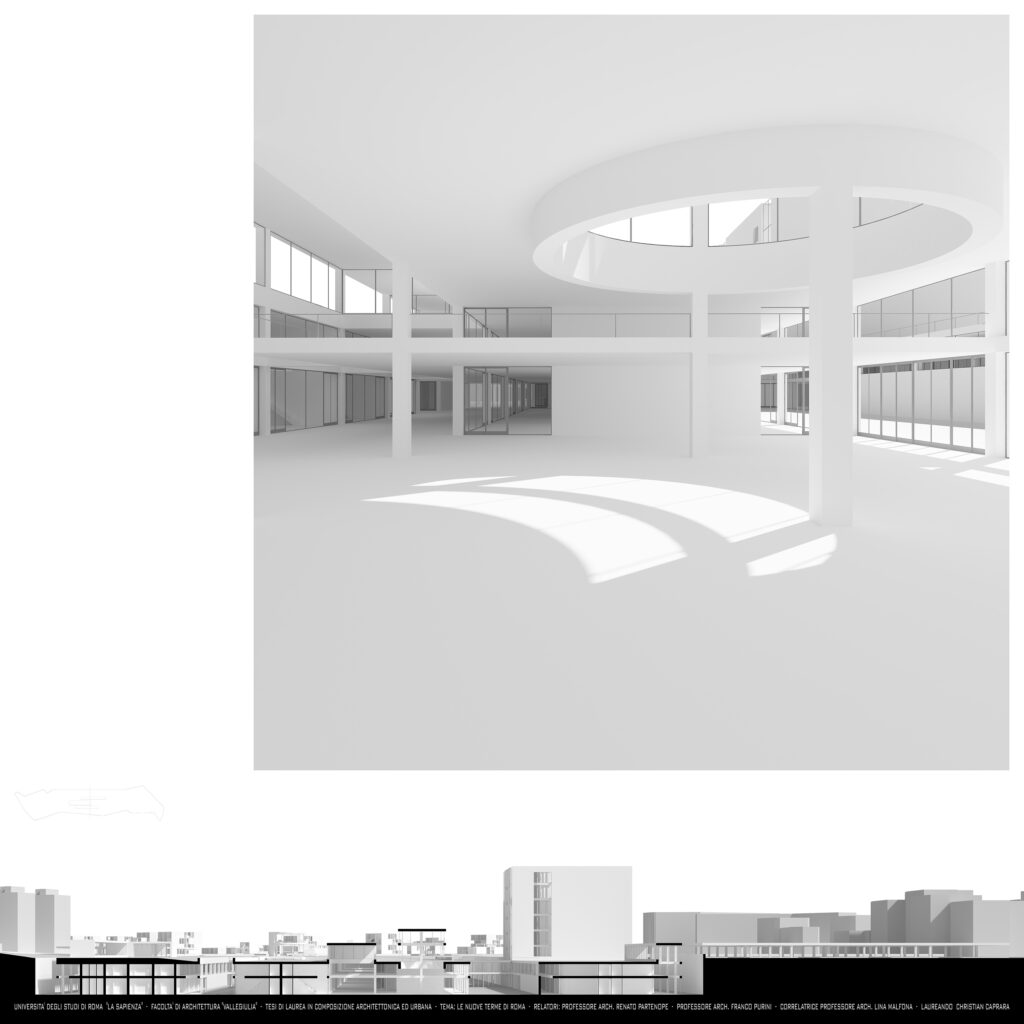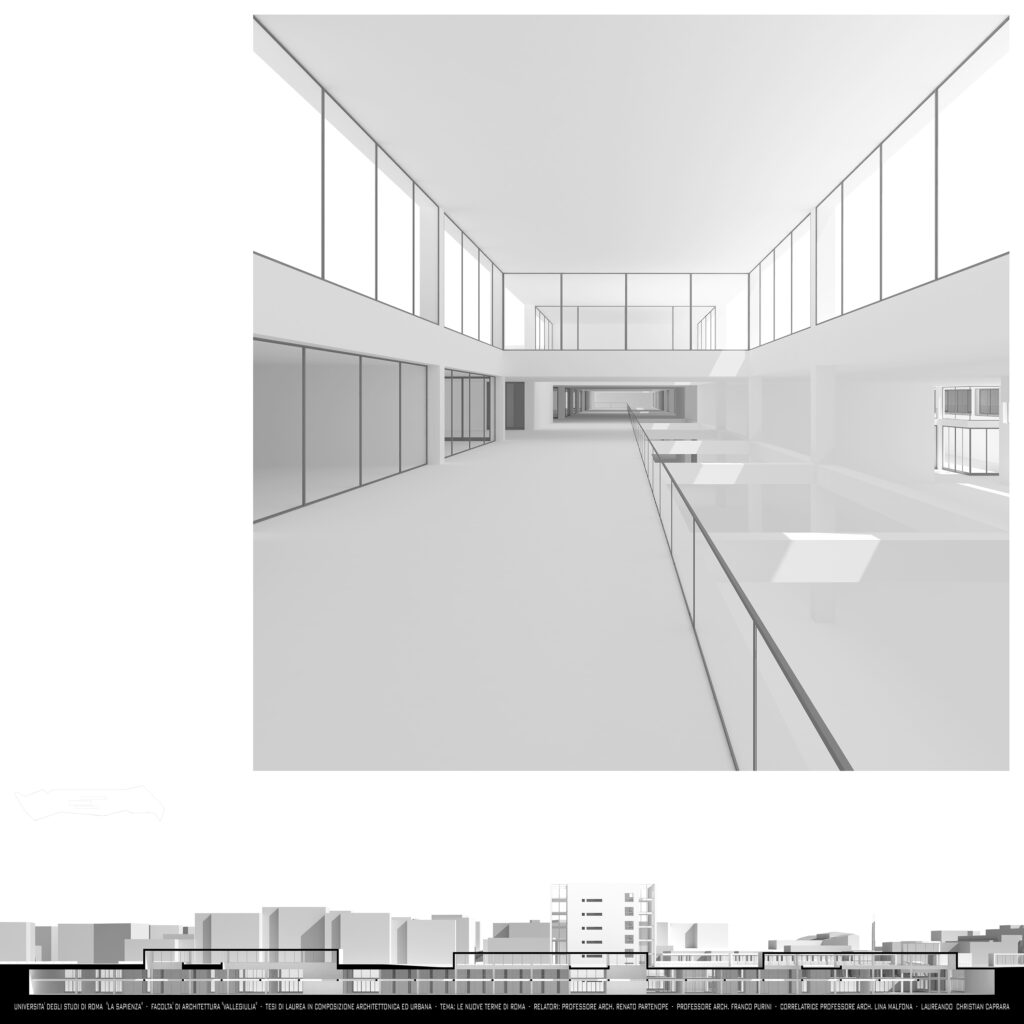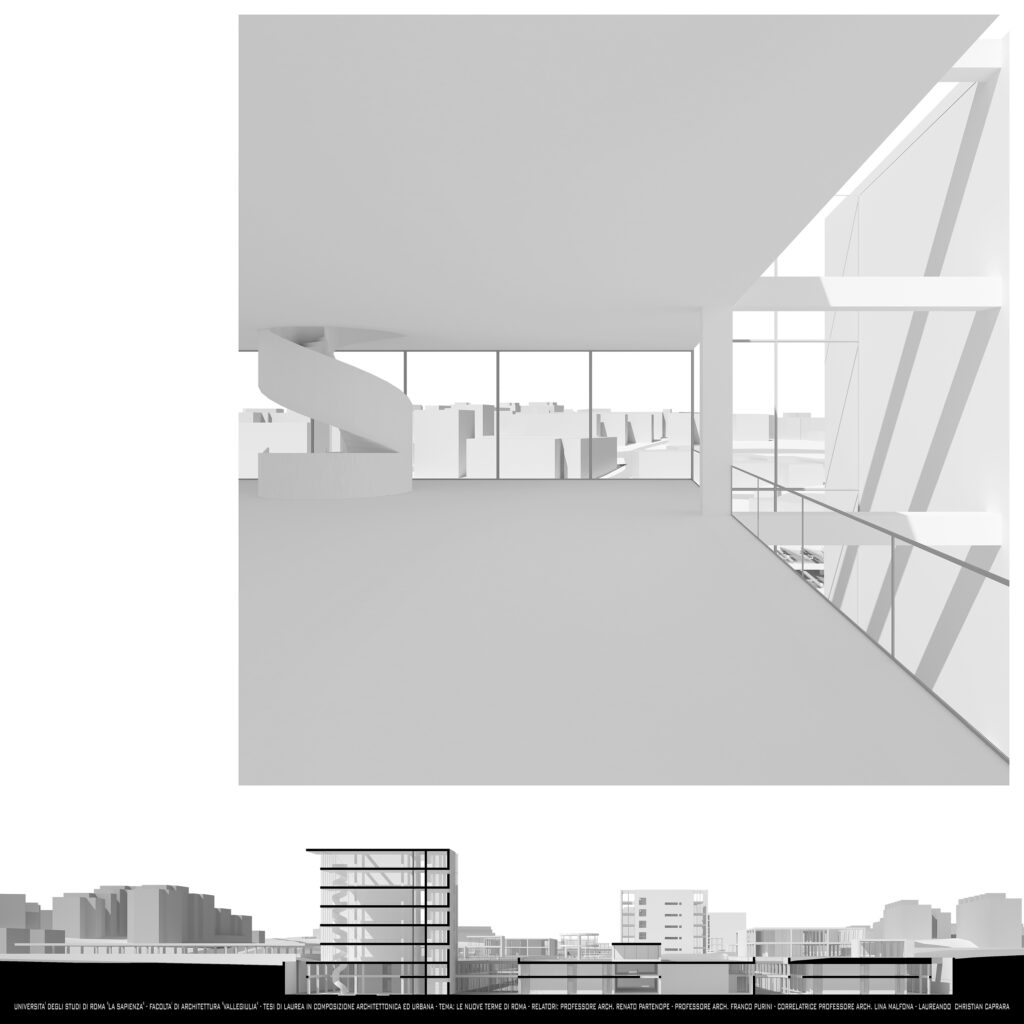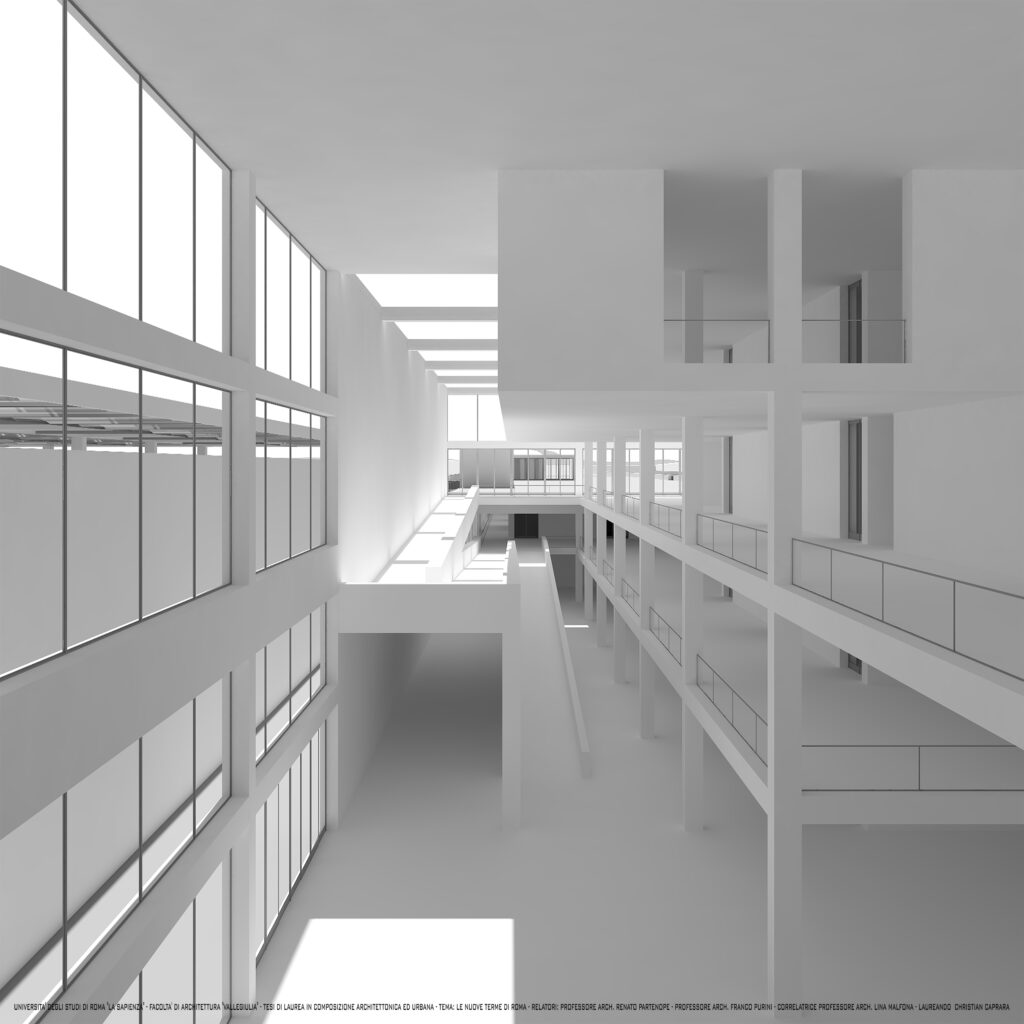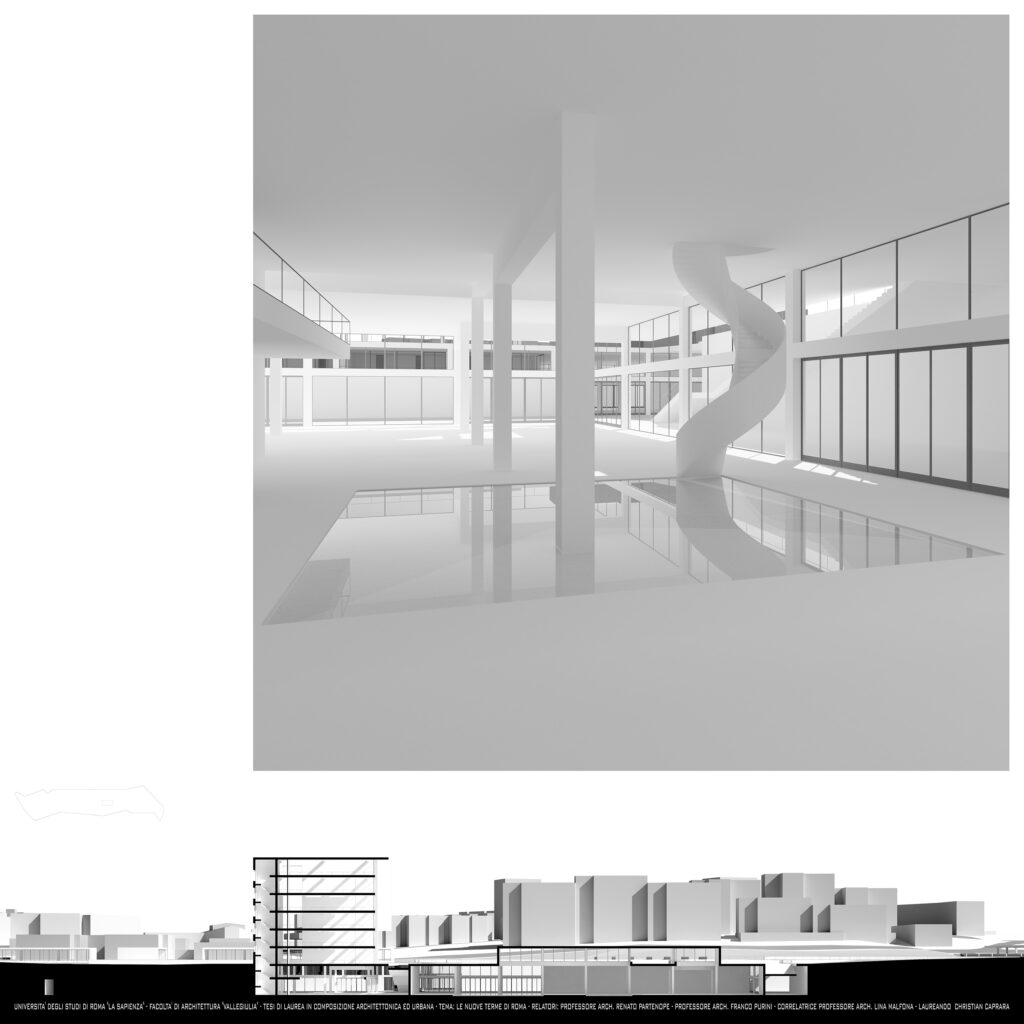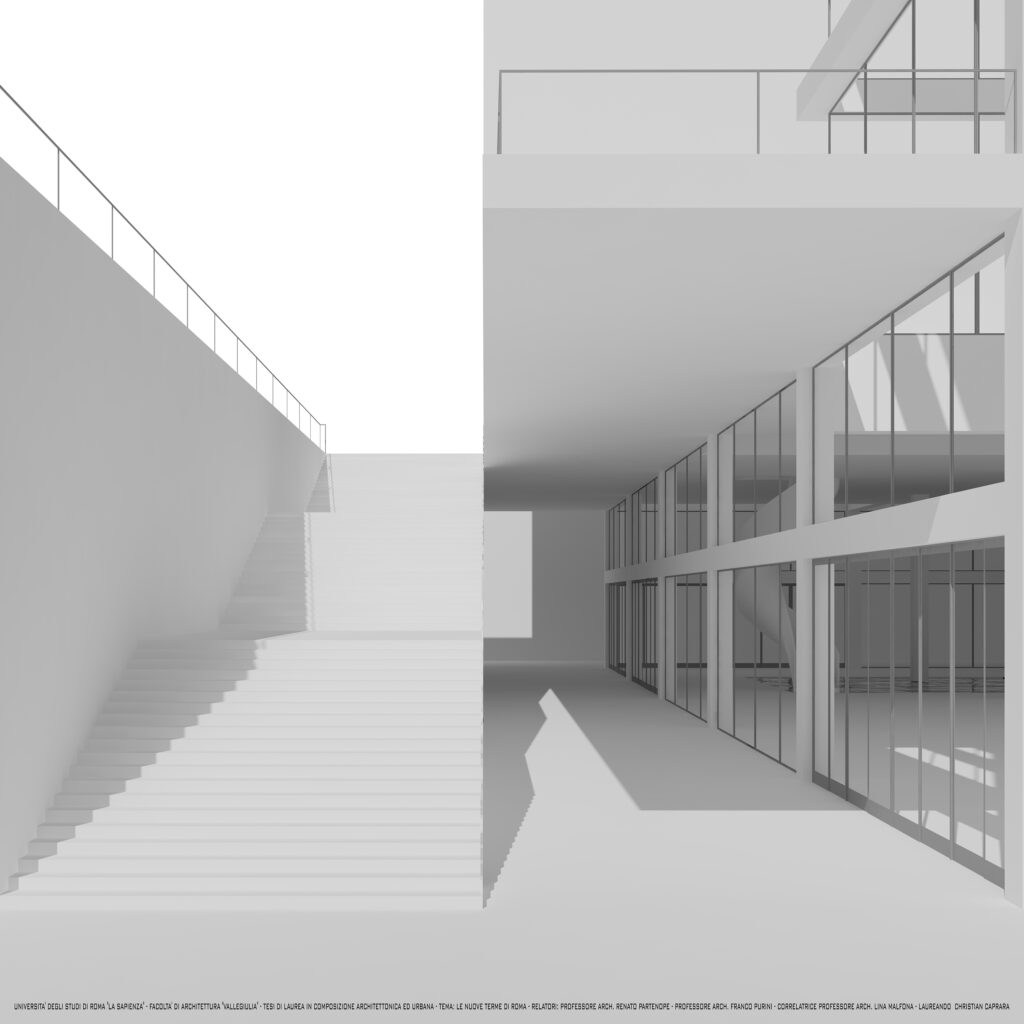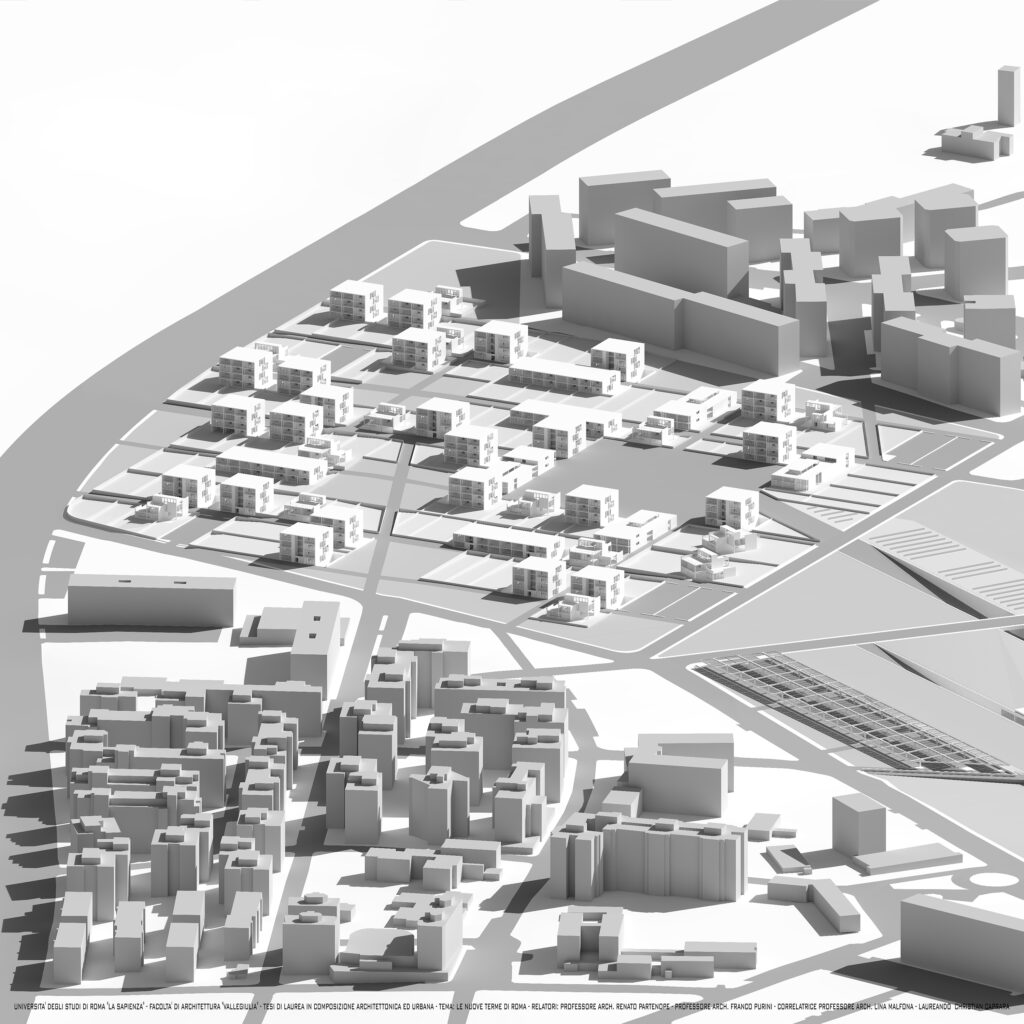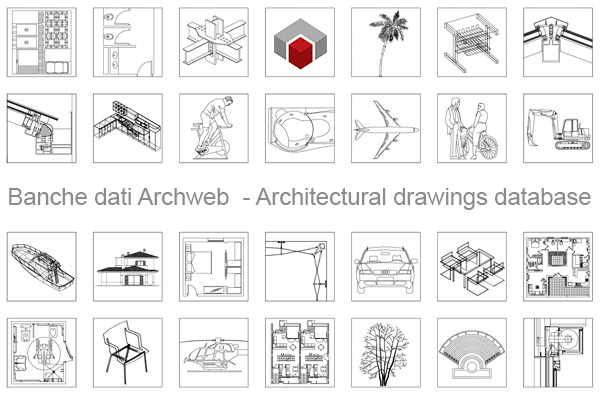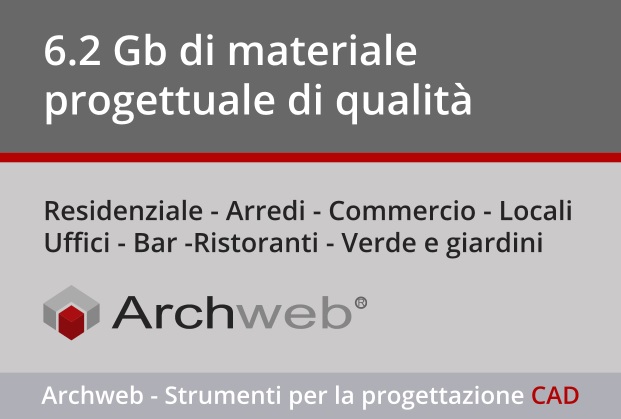Christian Caprara
Degree thesis in Architectural Design
THE NEW TERME DI ROMA: PROJECT FOR A WELLNESS PARK
Thesis by Christian CapraraContact email: christiancaprara@libero.it
University of Rome "La Sapienza" Faculty of Architecture "Valle Giulia"
Speakers: Prof. Arch. Renato Partenope - Prof. Arch. Franco Purini
Co-rapporteurs: Prof.ssa Arch. Lina Malfona
A.A. 2013 - 2014
The theme proposes the development of a lot located between the local centrality of Cinecittà and the district of Torre Spaccata. A site, the chosen one, which physically separates two nuclei belonging to the same urban fabric of the Roman suburbs.
"The urban growth of the X Municipio, Tuscolano-Cinecittà (Municipio VII, ex X), took place along the route of via Tuscolana, which connects the center of Rome with the Castelli Romani, and had a strong expansion in the period immediately after the war and in the 1960s ”. [...] "It is here, in fact, that in the early 1950s, the INA-house implemented an imposing building intervention; [...] at the same time the construction of the Don Bosco center was started with the church and the square in front of it, around which the neighborhood of the same name was built later. Still on via Tuscolana, the Cinecittà plants "[...]" and the headquarters of the Istituto Nazionale Luce were already built in 1937 and even today these structures, with their presence, characterize the area. Of great archaeological and naturalistic importance is the presence on the territory of the Parco degli Acquedotti, part of the larger Appia Antica Regional Park. " [...]
"Many interventions are planned in the territory of the municipality aimed at the rehabilitation of the spontaneous areas that arose during the 1970s, when an uncontrolled urban development of the suburbs took place. The New General Town Plan aims to bring these areas together with the city through the creation of a vast network of infrastructures and services ". [...] "The local centrality of Cinecittà also includes a transversal element that serves to strengthen the connection between the park of the Aqueducts and the future park of Centocelle, constituting the environmental system of the south-east area of the city" [...] " included in the urban and metropolitan centrality of Torre Spaccata. [...] The goal of centrality will be to provide quality elements, requalification, services and public spaces ".
"The Torre Spaccata neighborhood is located in the eastern sector of the city, within the ring road, close to via P. Togliatti, between via Casilina and via Tuscolana (Municipio VI, ex VIII). The first nucleus of the township was inaugurated on August 15, 1961 thanks to the implementation of the so-called Fanfani Plan of the Ina-Casa: designed as a popular residential district to contrast with the rampant unauthorized use of the suburbs, developed according to valid urban criteria, with constructions that did not exceed four floors and large green spaces, but implemented with a lack of services ". [1]
With the Piano delle Certezze and the new P.R.G., Torre Spaccata was destined in part to a park and in part to houses and offices, which would integrate with the surrounding urban fabric. [...] "The area will also house the Torre Spaccata archaeological park, areas equipped for leisure and services. The system of public spaces provides for the connection between the different parts, the greenery, the existing city and the new functions envisaged ".
[...] The new buildings will host multipurpose spaces and integrated public services within the new park which will mend the area of Torre Spaccata and the neighborhoods to the south ". [...] "The idea is to create a single system of services that unifies and integrates existing ones". [2]
The Wellness Park aims to connect and compensate urban fabrics and to create useful services for both centralities, playing a role as a balancing hinge and a possible flywheel for the surrounding activities.
A "node" that aims to recompose and unify the urban plot, joining the existing streets, through the development of pedestrian paths inside and driveways around the lot, creating walks in the greenery and characterizing the identity of the park. In addition, it has as its objective the requalification of the territory through the development of services absent in the area. A multipurpose center, which in its interconnection with the existing fabric, green areas and functions, can constitute a meeting point and meeting place in collective, sporting, indoor and outdoor spaces, in areas equipped for leisure, play and Relax.
The area, moreover, offers a very important and fundamental stimulus for the development of the thermal function, since it is located near the Park of the Aqueducts, which once fed Rome and its Thermal Baths.
Body care and bath practice have been present in all civilizations. The idea of SPA, "salus per aquam" (well-being through water), is very ancient: already in Hellenic Greece the bathroom had taken on a social character and the Roman baths took their origin from the fusion of the Greek gymnasium, which was composed of gyms and tubs, with the Egyptian steam bath. Two hundred years before Agrippa created the public baths, in 25 BC, the baths (balneum) were very popular with the Romans; later the Roman emperors competed to overcome their predecessors with increasingly grandiose spas: Nero in 65 AD, Titus in 81 AD, Domitian in 95 AD, Commodus in 185 AD, Caracalla in 217 AD, Diocletian in 302 AD. and Constantine in 315 AD.
During this long period, Imperial Baths were created everywhere, elaborated according to a precise scheme: along the central axis there were natatio (swimming pool), frigidarium cold water baths), tepidarium (warm water baths) and calidarium (hot water and steam baths) ); all the other associated functions were placed on the side.
[1] Municipality of Rome - Department VI - New Town Plan
[2] http://www.urbanistica.comune.roma.it/
"Mens sana in corpore sana" said Juvenal between the first and second centuries AD [3]; and almost two millennia later, things have evidently not changed much.
To better understand the meaning of well-being, it is necessary to cite the definition of "health" given by the World Health Organization, which defines it as follows: "state of complete physical, mental and social well-being and not simply the absence of disease". [4]
"In a phase of economic stagnation, there is a sector that continues to grow, albeit to a limited extent, and that of fitness and well-being. A recent sector study has shown a positive trend favored by factors that have changed the aspect of our society due to a progressive aging of the population. In Italy, according to an estimate by Censis, 50% of visitors to fitness centers are individuals aged between 16 and 24, 35% have a age between 25 and 55, with a very strong growth of adhesions by adults and, above all, the elderly. Another important factor is
greater attention by the individual to health and care of the physical aspect, from every point of view. "[5]
Therefore, it is necessary to think and build spaces, suspended between the emotions of the past and the needs of the present and future, which are an opportunity for balance, listening and rediscovering that well-being that makes us feel in harmony with ourselves and with the world.
The project has as its inspiring foundation the balance, the psychophysical and mental well-being of man. It is a place to restore sensory and material harmony, a meditation space for body and spiritual regeneration through the right relationship between the spaces, the plastic tension between the units, the use of eco-compatible materials, sustainable technologies and passive systems, with full respect for nature.
A path where perceptive-sensorial quality merges eurythmically with architecture, matter and relationship of proportions, where you can meet the needs of your inner and outer balance, which takes the visitor inside an engaging and highly experiential space.
The proposed building system consists of 3 large underground areas with annexed emerging towers, built to carry out the activity of the Wellness Park, a residential area, and large parking lots shielded by solar panels.
- The spa facility (located south-east of the lot) follows the Roman Imperial functional scheme: natatio, frigidarium, tepidarium and calidarium, simultaneously equipped with today's best technologies and surrounded by specific functional areas: saunas, mud, inhalation treatments, relaxation areas, gyms, emotional paths and a tower-library.
- The square is designed on two levels, the fulcrum of the project and the place of internal connection between functional spaces and walkways at high altitude, it also includes a congress-conference area and a tower-hotel.
- The building unit, located north of the lot, is dedicated to commercial activities, with shops for the sale of nutritional products and articles aimed at human well-being: organic restaurants, services and an office tower.
- The Residential area is located near Via P. Togliatti, consisting of three different construction types: building, cottage and in line, with adjoining urban gardens and tertiary type offices, arranged recovering the exemplary garden city scheme.
[3] Juvenal, X Satire, towards 365
[4] O.M.S., 1948; Mature A., Remuzzi G., 2005
[5] http://www.sanitaincifre.it/ Fitness and wellness, industry trends
Christian Caprara
Author
Category Christian Caprara































































